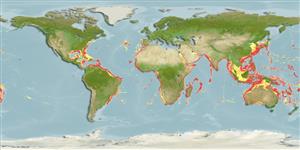Environment: milieu / climate zone / depth range / distribution range
экология
морской донно-пелагический; пределы глубины 9 - 1210 m (Ref. 9872), usually 200 - 500 m (Ref. 3583). Subtropical; 43°N - 35°S
Eastern Atlantic: Madeira and the Canary Islands to Senegal, Gulf of Guinea and South Africa. Western Atlantic: southern Scotian Shelf, Canada to Greater Antilles, western Caribbean, Panama and northern Gulf of Mexico (Ref. 7334). Indo-Pacific: off Natal (South Africa), Bay of Bengal, southern Australia, Chatham Plateau around New Zealand, and the Philippines (Ref. 4181). Also in northern South America (Moore, pers. comm.).
Size / Вес / Возраст
Maturity: Lm ? range ? - ? cm
Max length : 60.0 cm TL самец/пол неопределен; (Ref. 3695); common length : 45.0 cm TL самец/пол неопределен; (Ref. 3695)
колючие лучи спинного плавника (общее число) : 7 - 8; членистые (мягкие) лучи спинного плавника (общее число) : 13 - 14; колючие лучи анального плавника: 3; членистые (мягкие) лучи анального плавника: 11 - 12. Head with a concave forehead profile and with large mucous cavities covered by tough skin; mouth large and oblique; opercle and preopercle each with a large strong spine; body deep, about 2.1 times in SL; ventral keel with 10 - 14 very robust scutes; caudal fin forked but rounded. Color of head and body is dusky pink, sides with silvery tinge, fins red; tongue and gill cavity blackish; palate white to red (Ref. 7331). Pale beet red to light rosy. Back light red to brownish red, lower sides light silvery gray (Ref. 37108).
Lives close to or on the bottom of the upper continental slope. Prefers hard substrates. Young specimens feed on small shrimps and fish (Ref. 4784). A deep sea species, nonetheless, the young are often found near the coast (Ref. 9137). Utilized as fishmeal and source of oil in eastern central Atlantic (Ref. 3695).
Life cycle and mating behavior
половая зрелость | размножение | нерест | икра | Fecundity | личинки
Maul, G.E., 1990. Trachichthyidae. p. 620-622. In J.C. Quéro, J.C. Hureau, C. Karrer, A. Post and L. Saldanha (eds.) Check-list of the fishes of the eastern tropical Atlantic (CLOFETA). JNICT, Lisbon; SEI, Paris; and UNESCO, Paris. Vol. 2. (Ref. 3583)
Статус Красного Списка МСОП (Ref. 130435: Version 2024-1)
Угроза для людей
Harmless
Использование человеком
рыболовство: коммерческий; объект спортивного рыболовства: да
дополнительная информация
инструменты
Специальные отчеты
Скачать в формате XML
ресурсы в Интернет
Estimates based on models
Preferred temperature (Ref.
123201): 8.1 - 18.7, mean 12.2 °C (based on 848 cells).
Phylogenetic diversity index (Ref.
82804): PD
50 = 0.7500 [Uniqueness, from 0.5 = low to 2.0 = high].
Bayesian length-weight: a=0.01514 (0.00885 - 0.02590), b=3.07 (2.91 - 3.23), in cm total length, based on LWR estimates for this species & (Sub)family-body (Ref.
93245).
Trophic level (Ref.
69278): 3.9 ±0.65 se; based on food items.
устойчивость к внешним воздействиям (Ref.
120179): очень низкий, минимальное время удвоения популяции более 14 лет (Preliminary K or Fecundity.).
Fishing Vulnerability (Ref.
59153): Moderate vulnerability (44 of 100).
Nutrients (Ref.
124155): Calcium = 24.4 [10.0, 119.6] mg/100g; Iron = 0.646 [0.308, 1.494] mg/100g; Protein = 16.9 [15.5, 18.4] %; Omega3 = 0.319 [0.117, 0.902] g/100g; Selenium = 54.7 [19.5, 151.2] μg/100g; VitaminA = 24.7 [4.9, 138.9] μg/100g; Zinc = 0.632 [0.395, 1.045] mg/100g (wet weight);
